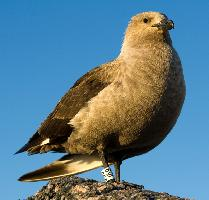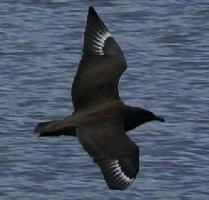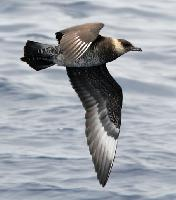
Popis zvířete
The Parasitic Jaeger, scientifically known as Stercorarius parasiticus, is a captivating bird of prey that belongs to the family Stercorariidae, which includes other jaegers and skuas. This medium-sized bird is known for its remarkable agility in flight and its unique feeding habits, which have earned it the name "parasitic" due to its penchant for harassing other birds to steal their food. Its name, derived from Latin, where "Stercorarius" means "pertaining to dung" and "parasiticus" indicating its parasitic feeding behavior, highlights its unique ecological niche.Physical Description:
The Parasitic Jaeger exhibits a degree of polymorphism, presenting in three main plumage color morphs: dark, intermediate, and light. Adults typically measure between 41 to 58 centimeters in length, with a wingspan ranging from 110 to 125 centimeters, and weigh approximately 300 to 650 grams. They possess pointed wings and a long, pointed central tail feather that distinguishes them from other jaeger species, especially evident in adults. The bird's plumage varies with age and morph, but generally, adults have a dark cap, and their body color can range from a uniform dark brown to a mixture of brown and white, with the lighter morphs displaying more white, especially on the underparts and face.
Distribution and Habitat:
The Parasitic Jaeger has a circumpolar distribution, breeding in the Arctic regions of Europe, Asia, and North America. Its habitat includes tundra, coastal islands, and beaches, where it nests on the ground, often in solitary pairs that are widely dispersed. After the breeding season, it migrates southwards to spend the winter in more temperate and tropical oceans worldwide, showing a remarkable adaptability to different marine environments.
Behavior and Diet:
The Parasitic Jaeger is best known for its aggressive behavior in pursuit of food. It often chases other seabirds such as terns and gulls, forcing them to regurgitate their recent catch, which the jaeger then skillfully catches in mid-air. This kleptoparasitic behavior is a hallmark of its feeding strategy, although it also hunts for fish, small mammals, and insects. During the breeding season, it is fiercely territorial and will defend its nest against any intruders with bold, swooping attacks.
Reproduction:
Breeding takes place once a year, with the laying of one to two eggs. Nests are simple scrapes on the ground, often lined with bits of vegetation. Both parents share the responsibility of incubating the eggs over a period of about 27 days, and they are equally involved in feeding and protecting the chicks. The young fledge approximately 35 to 42 days after hatching but remain dependent on their parents for food and protection for several weeks thereafter.
Conservation Status:
The Parasitic Jaeger is currently classified as Least Concern by the International Union for Conservation of Nature (IUCN), indicating that it does not face any immediate threat of extinction. However, like many species, it is vulnerable to the broader impacts of climate change and habitat disturbance, which could affect its breeding grounds and food supply. Conservation efforts focus on monitoring populations and protecting important breeding and wintering habitats to ensure the species' long-term survival.
In summary, the Parasitic Jaeger is a fascinating bird with unique behaviors and adaptations that allow it to thrive in a variety of marine and coastal environments. Its remarkable agility in flight, combined with its opportunistic feeding habits, make it a compelling subject of study for ornithologists and bird enthusiasts alike.
Podobná zvířata
Nové fotografie zvířat
Top 10 zvířat
- Chinese water dragon (Physignathus cocincinus)
- Galápagos tortoise (Geochelone nigra complex)
- Dolphin gull (Leucophaeus scoresbii)
- Japanese macaque (Macaca fuscata)
- Colombian red howler (Alouatta seniculus)
- Sea urchins (Echinoidea)
- Diana monkey (Cercopithecus diana)
- Moustached guenon (Cercopithecus cephus)
- Common reed warbler (Acrocephalus scirpaceus)
- Common house mosquito (Culex pipiens)


